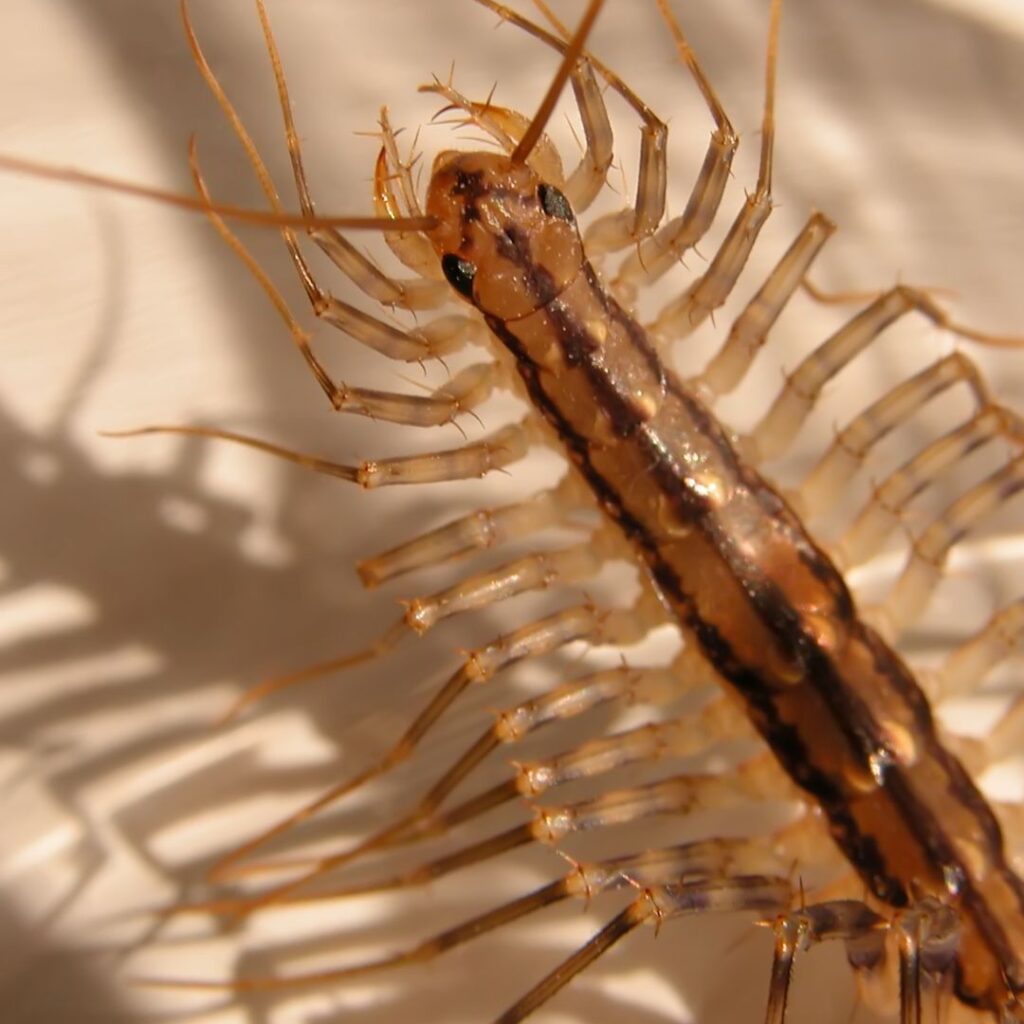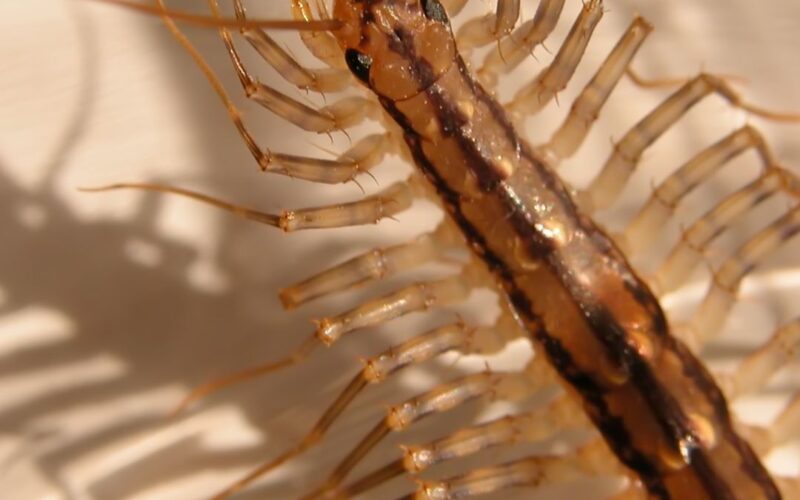
Table of Contents
You flick on the bathroom light at midnight, and there it is.
A blur of long legs darts across the wall faster than your eyes can follow.
For a split second, your heart skips.
What was that thing? Chances are, you’ve just met the house centipede.
With their 15 pairs of legs and alien-like speed, house centipedes (Scutigera coleoptrata) look like something out of a horror film. But here’s the twist: they’re not dangerous.
In fact, they’re predators that feed on other pests like spiders, cockroaches, silverfish, and ants. In other words, the creepy creature you just saw might actually be doing you a favor.
Still, most homeowners agree, no matter how “helpful” they might be, you don’t want house centipedes racing across your bathroom floor.
In this article, we’ll walk you through how to get rid of house centipedes step by step.
From reducing moisture and sealing entry points to tackling the other pests that attract them. You’ll also learn why they show up in your home, what risks they actually pose and when it’s time to call in a professional.
By the end, you’ll have a clear, practical plan to keep your home comfortable and centipede-free.
Understanding house centipedes
House centipedes are fast-moving arthropods native to the Mediterranean but now found worldwide, including across North America.
They’re easy to recognize once you know what to look for:
- Appearance: Yellowish-grey or brown bodies with three dark stripes along their length. Their bodies measure 1–1.5 inches, but their long legs and antennae can make them appear up to 4 inches in size.
- Legs: They have 15 pairs of banded legs, with the last pair on females almost twice the body length.
- Behavior: Nocturnal hunters that emerge at night, feeding on smaller pests. During the day, they hide in dark, moist spaces.
- Life Cycle: Starting with only 4 pairs of legs as larvae, they add more with each molt until adulthood. Females lay between 35–100 eggs at a time, and centipedes can live for several years.
While their appearance is alarming, house centipedes are not destructive to homes, furniture, or food supplies. Their main interest is hunting other pests.
Are House Centipedes Dangerous?
The good news is that centipedes are more scary-looking than harmful.
- Bites: While they can bite using their modified front legs (forcipules), it’s extremely rare. At worst, it may feel like a bee sting.
- Health risks: They don’t carry diseases, don’t damage structures, and don’t infest food.
- Unexpected benefits: By eating cockroaches, ants, and silverfish, they can actually help keep your home cleaner.
That said, their unsettling appearance is enough reason for most homeowners to want them gone. And if you’re seeing a lot of them, it likely points to a bigger pest issue that needs addressing.
How to Get Rid of House Centipedes (Step-by-Step)
Now that you know why centipedes move indoors, here are the most effective ways to get rid of them and prevent them from coming back.
Reduce Moisture in the Home
If there’s one thing house centipedes love, it’s moisture.
These pests thrive in damp environments, which is why basements, bathrooms, laundry rooms, and crawlspaces are their favorite hangouts.
The first step in getting rid of them is making your home less inviting.
- Fix leaky pipes or faucets. Even small drips under a sink or behind a washing machine can create the perfect damp corner where centipedes will hide.
- Use a dehumidifier. In basements or other damp rooms, aim to keep humidity below 50%. This makes the environment less comfortable for centipedes and their prey.
- Improve ventilation. Use bathroom fans, open windows, or vent covers to keep air moving and reduce trapped humidity.
Think of it this way: if you cut off the water supply, you’re removing the “oasis” centipedes are searching for. Dry spaces mean fewer pests and a much more comfortable home for you.
Eliminate Their Hiding Spots
Centipedes are fast and stealthy, but even they need places to hide during the day. That’s why tackling clutter and sealing entry points is such a powerful way to reduce their presence indoors.
- Seal cracks, crevices, and gaps. Even tiny spaces around windows, doors, or foundations are big enough for centipedes. Use caulk, foam sealant, or weatherproofing.
- Declutter storage areas. Cardboard boxes, piles of clothes, and old newspapers provide endless hiding spots. Swap cardboard for plastic bins with tight-fitting lids.
- Keep firewood outdoors. Logs stacked inside the home are perfect insect condos. Only bring in the firewood you’ll use immediately.
- By removing the nooks and crannies where centipedes hide, you make your home less of a maze for them to disappear into.
Here’s the thing about house centipedes, they don’t come into your home for you, they come for dinner. Their diet includes cockroaches, ants, silverfish and spiders. That means if you’re seeing centipedes regularly, you probably have another pest problem hiding in the background.
Control Their Food Source (Other Pests)
- Address infestations directly. Use traps, baits, or professional services to deal with roaches, ants, or silverfish.
- Keep your home clean. Vacuum regularly, wipe down surfaces, and store food in sealed containers. Even crumbs can attract pests.
- Repair screens and doors. Small tears in window screens or gaps under doors are open invitations for insects and in turn, centipedes.
When you remove their food source, centipedes have no reason to stick around. Think of it as cutting off the supply line the predators will move elsewhere when the prey disappears.
Direct Removal Methods
Sometimes, even with prevention strategies, you’ll still spot a centipede scurrying across the floor. In those moments, you’ll want quick, direct ways to get rid of them.
- Sticky traps: Place them in dark, damp corners like under sinks or along basement walls. They’re inexpensive and effective.
- Vacuuming: A fast, mess-free way to remove a centipede on sight. Just empty the vacuum afterward.
- Catch and release: If you prefer not to kill them, use a jar and piece of paper to carry them outdoors.
Note: Insecticides are usually ineffective against house centipedes. They move too quickly and often hide in places sprays can’t reach. Focus instead on prevention and direct removal.
Natural and Preventive Methods
For those who prefer natural solutions, several household-friendly options can discourage centipedes and the pests they feed on:
- Essential oils: Tea tree and peppermint oils work well as repellents. Spray diluted mixtures along baseboards and entry points.
- Diatomaceous earth: This natural powder damages insects’ exoskeletons. Sprinkle lightly in corners, under appliances, and near entryways.
- Weatherstripping: Properly sealing doors and windows not only blocks centipedes but also keeps out many other pests.
And remember the golden rule: a dry, clutter-free, well-sealed home is naturally resistant to centipedes. Prevention is always more effective than chasing them around after the fact.
When to Call a Pest Control Professional
Most homeowners can manage occasional centipede sightings with the steps above. However, it may be time to call a pest control professional if:
- You’re seeing centipedes frequently, suggesting a larger pest problem.
- Moisture issues are structural and difficult to control on your own.
- DIY methods haven’t reduced centipede activity after several weeks.
A professional inspection can uncover hidden pest infestations and moisture sources, helping you solve the root problem rather than just the symptoms.
At the end of the day, house centipedes aren’t your enemy. They’re more like uninvited houseguests. While they may look terrifying, they’re not out to harm you, your family, or your pets.
In fact, they’re hunting down the very pests you don’t want around. Still, that doesn’t mean you have to put up with them racing across your walls at night.
The good news is that keeping house centipedes away doesn’t require harsh chemicals or endless battles. Instead, it comes down to three core strategies: reduce moisture, eliminate hiding spots, and control their food sources.
Add in direct removal methods, natural deterrents, and some preventive maintenance, and you’ve got a solid plan for making your home less appealing to these creepy crawlers.
Remember, their presence is often a clue that other pests are nearby. By managing the environment and sealing up entry points, you’re solving not just your centipede problem but also preventing a whole range of other infestations.
